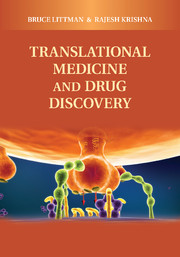Book contents
- Frontmatter
- Contents
- Contributors
- Preface
- Translational Medicine and Drug Discovery
- SECTION I TRANSLATIONAL MEDICINE: HISTORY, PRINCIPLES, AND APPLICATION IN DRUG DEVELOPMENT
- SECTION II BIOMARKERS AND PUBLIC–PRIVATE PARTNERSHIPS
- 8 BIOMARKER VALIDATION AND APPLICATION IN EARLY DRUG DEVELOPMENT: IDEA TO PROOF OF CONCEPT
- 9 IMAGING BIOMARKERS IN DRUG DEVELOPMENT: CASE STUDIES
- 10 EUROPEAN NEW SAFE AND INNOVATIVE MEDICINES INITIATIVES: HISTORY AND PROGRESS (THROUGH DECEMBER 2009)
- 11 CRITICAL PATH INSTITUTE AND THE PREDICTIVE SAFETY TESTING CONSORTIUM
- 12 THE BIOMARKERS CONSORTIUM: FACILITATING THE DEVELOPMENT AND QUALIFICATION OF NOVEL BIOMARKERS THROUGH A PRECOMPETITIVE PUBLIC–PRIVATE PARTNERSHIP
- SECTION III FUTURE DIRECTIONS
- Index
- References
11 - CRITICAL PATH INSTITUTE AND THE PREDICTIVE SAFETY TESTING CONSORTIUM
Published online by Cambridge University Press: 04 April 2011
- Frontmatter
- Contents
- Contributors
- Preface
- Translational Medicine and Drug Discovery
- SECTION I TRANSLATIONAL MEDICINE: HISTORY, PRINCIPLES, AND APPLICATION IN DRUG DEVELOPMENT
- SECTION II BIOMARKERS AND PUBLIC–PRIVATE PARTNERSHIPS
- 8 BIOMARKER VALIDATION AND APPLICATION IN EARLY DRUG DEVELOPMENT: IDEA TO PROOF OF CONCEPT
- 9 IMAGING BIOMARKERS IN DRUG DEVELOPMENT: CASE STUDIES
- 10 EUROPEAN NEW SAFE AND INNOVATIVE MEDICINES INITIATIVES: HISTORY AND PROGRESS (THROUGH DECEMBER 2009)
- 11 CRITICAL PATH INSTITUTE AND THE PREDICTIVE SAFETY TESTING CONSORTIUM
- 12 THE BIOMARKERS CONSORTIUM: FACILITATING THE DEVELOPMENT AND QUALIFICATION OF NOVEL BIOMARKERS THROUGH A PRECOMPETITIVE PUBLIC–PRIVATE PARTNERSHIP
- SECTION III FUTURE DIRECTIONS
- Index
- References
Summary
Introduction to the Critical Path in Medical Product Development
Critical Path Institute (C-Path) is an independent, nonprofit institute created in 2005 by the University of Arizona and the U.S. Food and Drug Administration (FDA). C-Path is dedicated to bringing scientists from the FDA, the European Medicines Agency (EMA), industry, and academia together in collaborative research, endeavoring to improve the path for innovative new drugs, diagnostics, and devices to reach patients in need. C-Path's programs are designed to address the scientific, safety, and educational aspects of medical product development in support of the FDA's Critical Path Initiative (http://www.fda.gov/oc/initiatives/criticalpath/initiative.html). Released in 2004, the FDA's Critical Path Report analyzed input from FDA scientists and stakeholders on opportunities and challenges along the critical path of medical product development. Although not perfectly analogous, similar initiatives to improve drug safety or efficacy originating in Europe include the InnoMed PredTox collaboration (http://www.innomed-predtox.com) and, more recently, the Innovative Medicines Initiative (http://imi.europa.eu). Although the operational model for governance and execution of research varies widely, the objectives of each endeavor include the regulator's stated priorities for improving drug development and have resulted in the creation of new pathways and processes at the FDA and the EMA for reviewing and applying novel data often independent of a particular drug application.
To serve as a neutral and trusted third party for collaborators, C-Path does not accept funding from organizations that develop products regulated by the FDA or that would create a real or perceived conflict of interest.
- Type
- Chapter
- Information
- Translational Medicine and Drug Discovery , pp. 289 - 294Publisher: Cambridge University PressPrint publication year: 2011



